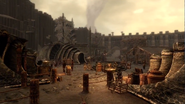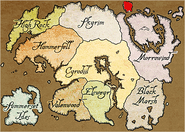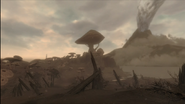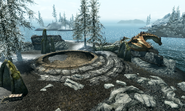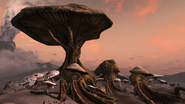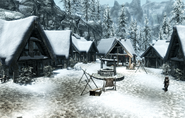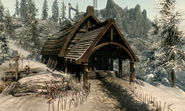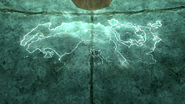Vincentius1 (talk | contribs) |
Vincentius1 (talk | contribs) |
||
| Line 144: | Line 144: | ||
====Miraak's Downfall; At the Summit of Apocrypha==== |
====Miraak's Downfall; At the Summit of Apocrypha==== |
||
| + | [[File: ApocryphaSky.jpg|thumb|300px|The realms of Apocrypha contain ancient and forbidden knowledge. It is the domain of Hermaeus Mora.]] |
||
| + | {{Quote|The infinite archives of Hermaeus Mora are the ultimate treasure. Its innumerable shelves and countless books carry the weight of all knowledge. Therein, the diligent reader can find all that was, all that is, and all that will be. We have seen the truth. Knowledge is only as wicked as the one who wields it. Forsaking learning in fear of its misuse is the ultimate sin. It is an unforgivable folly. As a result, mortals have suffered countless centuries of loss.|Anonymous|Apocrypha, Apocrypha}} |
||
====The Revival of Raven Rock; the Second Golden Age==== |
====The Revival of Raven Rock; the Second Golden Age==== |
||
Revision as of 18:21, 24 September 2018
- "Therefore, I humbly beseech any students of history who might encounter this modest text to travel to Solstheim and learn all that can be learned of this noble people and their ancient customs. The Skaal people might not be long for this world, but let us assure that their proud and noble legacy lasts well into the future."
- ―Tharstan of Solitude[src]
Solstheim or Soulstheim is an island region located on the Sea of Ghosts, between the provinces of Skyrim and Morrowind. For the longest time, Solstheim held little significance until around 3E 427, when the East Empire Trading Company began to set foot onto the land and build their colony. It has evolved since the disaster in 4E 5, when the High King of Skyrim gave Solstheim to Dark Elven refugees. The Skaal Tribe of Nords have lived on Solstheim since the Merethic Era. It is known as the "Jewel of Absolutely Nothing."
By game
Description
Geography
Felsaad Coast
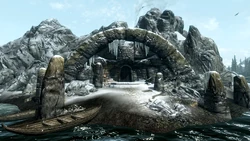
Gyldenhul Barrow is one of the many pirate coves found on Felsaad Coast.
The Felsaad Coast consists of the northeast of Solstheim, and it is the home of the native Nordic population, as the Skaal Village is located on the northeast bluffs. Much of the region has been used by the Skaal Tribe, from not only the village but the subsidiary settlement of the Thirsk Mead Hall, which was founded by a sub-group of the Skaal. The mead hall is found on the other side of the region, on the shores of Lake Fjalding. Minor islands are found on the water, a notable one is the Gyldenhul Barrow, the ancient burial tomb of the infamous Nordic pirate, Haknir Death-Brand. It is found on Horker Island.
Hirstaang Forest

The Hirstaang Forest was obliterated in the Red Year, resulting in a barren Ashland.
The Hirstaang Forest consists of the southern half of Solstheim, and it is the center of the region's commerce, as the settlements of Raven Rock and Fort Frostmoth are found here. Compared to the north, Hirstaang is tame, containing some minor farmlands, outside the Raven Rock walls. Fort Frostmoth was the first settlement in the land, until in 3E 427, the township of Raven Rock was founded. When the Red Year occurred, the sudden ashstorms had practically destroyed the Hirstaang Forest. Fort Frostmoth was swallowed by the ash, and thanks to House Redoran, Raven Rock was able to survive, barely. Dead trees currently riddle the landscape, a shell of its former self.
Isinfier Plains

The Tomb of Vahlok the Jailor is hidden amidst the forests of the Isinfier Plains.
The Isinfier Plains of Solstheim takes the central east of the island, found between the Hirstaang Forest and the Felsaad Coast. The plains are largely barren, as no known settlements can be found here. Only Witches and Reavers live in this region. A small fraction of the Glenmoril Witches live in Isinfier, utilizing the Altar of Thrond as their base of operation. Many natural caverns are found here, such as the Cave of Hidden Music and the Solvjord. In the deep forest lies Vahlok's Tomb, the burial place of the ancient Dragon Priest, Vahlok the Jailor, who faced the Traitor, Miraak in the Merethic Era. Vahlok lives in Skaal culture as "the Guardian."
Moesring Mountains
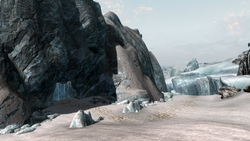
Castle Karstaag was a fortress that housed a legendary Frost Giant named Karstaag.
The Moesring Mountains are the frozen wastes of Solstheim, being found in the northwest, separated by the mountain range by the same name. It is nothing but cold seas of snow, with the occasional cave system, such as Benkongerike and Domme. The only "settlement" in the region is Castle Karstaag, a glacier fashioned into a castle, with dining rooms and long hallways. The Frost Giant, Karstaag lives in the castle. On the northwest, lies the Mortrag Glacier, which engulfs the entire northwest coast. By 4E 5, it was gone and more natural caves were discovered. The Dragon Lair known as Saering's Watch is found overlooking the north.
Fauna
Rieklings & Bristlebacks
Grahl
Ash Creatures
Lurker
Frost Giant
Miscellaneous Creatures
Flora
Government
Religion
History
Merethic Era
The Battle of the Moesring & the Fall of the Snow Prince

The Snow Prince's Ancient Steel Armor & his mighty spear are kept in the catacombs of Jolgeirr Barrow.
- "Like a sudden, violent snow squall that rends travelers blind and threatens to tear loose the very foundations of the sturdiest hall, the Snow Prince did sweep into our numbers. Indeed the ice and snow did begin to swirl and churn about the Elf, as if called upon to serve his bidding. The spinning of that gleaming spear whistled a dirge to all those who would stand in the way of the Snow Prince, and our mightiest fell before him that day."
- ―Lokheim[src]
In the late Merethic Era, the Atmorans under Ysgramor had traveled south to the modern-day lands of Skyrim, building their first city of Saarthal. However, the Snow Elves had besieged the city and drove out the Atmorans in the event known as the Night of Tears. Sometime later, Ysgramor returned to Skyrim and had begun his purge against the Snow Elves in the Nordic-Falmer War, spanning for quite some time. The last known battle was on the region of Solstheim, in the Battle of the Moesring, the last stand of the Falmer. Leading the remaining Falmer is the Snow Prince, the last of the Snow Elven hierarchy. Ysgramor had traveled for Solstheim after devastating the Falmer on the mainland, encountering the remnants of the Snow Elven Army at the Moesring Mountains in the northwest.[1]
In the beginning, the Atmorans were overwhelming the Snow Elves, cutting through them with ease until the arrival of the Snow Prince, who singlehandedly crushed the Atmorans greatly. The Spear of the Snow Prince was legendary for the battle, as it killed various figures, such as Freida Oaken-Wand and Heimdall the Frenzied. Amidst the slaughter, the Snow Prince had killed the mother of a lowly twelve-year-old girl, Finna, a squire to her mother. Enraged, Finna grabbed her mother's sword and pierced it into the Snow Prince's breast. This gave the Atmorans the leeway to ultimately defeat the Snow Elves in Solstheim. This was the end of the elven race's illustrious history, although small remnants took to isolation, never to be heard from. Ysgramor and his chieftain gave the Snow Prince a proper burial, with the exception of Stalhrim, which was reserved for Nords. His burial ground became Jolgeirr Barrow. From then on, the Nords had conquered Solstheim, and eventually, the Dwemer settled in lands far from Nordic cities, resulting in Nchardak and Fahlbtharz.[1][2]
Solstheim's Creation Myth; The Guardian & the Traitor

The battle between Vahlok & Miraak resulted in the land splitting and becoming Solstheim.
- "The Guardian, whom the legend presents as a paragon of loyalty and nobility, finally defeats the despicable Traitor, who seems to represent all that is corrupt and evil in men. Their epic duel is clearly representative of a greater struggle between good and evil. Perhaps it is this timeless quality that has kept the tale alive for so long."
- ―Lucius Gallus[src]
The modern-day Skaal of Solstheim are the descendants of the Dragon Cult that ruled over Solstheim, sometime after Ysgramor's reign, as the Dragon Cult was prominent. One such priest, Miraak, who was the first known Dragonborn, long before the appearance of St. Alessia in Cyrodiil. Miraak had come into contact with Hermaeus Mora, the Daedric Prince of Forbidden Knowledge. The Wretched Abyss had lured Miraak with great knowledge, and the ability to Bend the Will of Dragons, and so he plotted against his Dragon Overlords, killing them in numbers outside his grand temple. Miraak could absorb the Dragon Souls, giving them unbeknownst power that would eventually lead to their downfall. Three Dragon Priests, known as the Acolyte Priests, would follow Miraak and disown the Dragon Cult.[3][4]
The leaders of Bromjunaar had sent the Warrior-Priest, Vahlok to defeat Miraak. The battle between these two forces resulted in the mainland splitting, and that broken piece of land became modern-day Solstheim. In an epic battle between good and evil, the two priests had battled until Vahlok had emerged victorious. The Acolyte Priests were defeated, from Ahzidal to Zahkriisos. While other tales would end it here, the truth is different. Before Vahlok would kill him, Miraak withdrew into Apocrypha, while Vahlok the Guardian stays vigilant for his return. The Tale of the Guardian & the Traitor became a cautionary tale to the Skaal Tribe, as a warning for the inevitable return. Vahlok became the ruler of Solstheim, and the Dragon Cult of Solstheim remained isolated from the rest, resulting in their transformation into the modern-day Skaal.[3]
Second Era
Records of Solstheim throughout the Years

The Skaal Village & Thirsk were the only settlements on Solstheim (before Fort Frostmoth or Raven Rock).
- "After meeting King Logrolf, I took the time to examine a display of clothing from the many subcultures of Skyrim, which it seems is home to other peoples than just those mainstream Nords so well-known across northern Tamriel. But I also came across the clothing of a culture previously unknown to me, that of the Skaal, who inhabit an island in the Sea of Ghosts named Solstheim (I hope I've spelled that right—my notes were taken in haste)."
- ―Doctor Alfidia Lupus[src]
Solstheim's history since the Dragon Cult is largely unknown, but it has appeared in history since the Merethic Era, and before even Tiber Septim's rise to power. Despite the Skaal's isolation, they are acknowledged by the government of Skyrim, as High King Logrolf, who was alive during the reign of Versidue Shaie, had a set of Stalhrim Armor on display, courtesy of the Skaal. The island of Solstheim was considered a territory of Skyrim, ever since the Battle of the Moesring, and so it has been used by the province, but it did not have a known centralized settlement like the East Empire Trading Company had with Fort Frostmoth. Because of how unpopulated Solstheim is, many people took to the island for a private retreat, where one scholar lived in White Ridge Barrow to conduct experiments on explosive, elemental spiders. With the schism that had befallen onto Skyrim, it is unknown which kingdom claimed Solstheim but considering its location; it was likely claimed by the Eastern Kingdom. It was unharmed, nor utilized by the invading Kamali Army in the Second Akaviri Invasion, as they bypassed the island and headed straight for Windhelm. Second Era cartography has depicted Solstheim among other the other provinces, in the seas shared by Skyrim and Morrowind, but as the time went on, the island of Solstheim had become forgotten until in the late Third Era.[5][6][7][8][9]
Third Era
- Main article: Solstheim (Bloodmoon)
Hrothmund the Red & Thirsk Mead Hall

Hrothmund the Red was the de-facto leader of the Thirsk, fighting against the Udyrfrykte.
- "On the eastern bank of Lake Fjalding stands Thirsk, a grand mead hall that serves as the home and center of operations for a most valiant clan of Nord warriors. Approximately one hundred years ago, a small group of Skaal decided to leave the main village, and free themselves of their brethren's strict adherence to nature worship. They sought to live life as their ancestors had in Skyrim -- free to kill what they wanted when they wanted, free to worship in any manner they chose."
- ―Bereditte Jastal[src]
The Skaal are a spiritual-folk, one that has deviated from the Nordic culture that the race is known for. A group of Skaal decided to leave the Skaal and their strict religious culture, seeking the thrill of fighting by his own free will. Leading the helm was Hrothmund the Red, who took his group of warriors across the Felsaad Coast, until he spotted a plot of land along Lake Fjalding. Within the span of several months, the Thirsk Mead Hall was constructed. However, the construction of Thirsk had caused the creature, the Udyrfrykte had awoken from the Caves of Fjalding. Wreaking havoc on Thirsk. The Thirsk Nords dwindled half in numbers, but fortunately, the wizard named Eldrid Ice-Light sealed the creature back into the cave. Two months later, Thirsk was rebuilt. But with the Udyrfrykte dealt with, another problem arose when Drengr Bronze-Helm had questioned Hrothmund's leadership, and sought to become Chieftain. In response, Hrothmund had cleaved Drengr's head off and placed it onto his mantle. It became the symbol of his leadership, and that he was indeed worthy of being the Chieftain of Thirsk. And so the ancient tradition was born. Any race or sex could attempt to claim the throne, as long as, they presented an honorable trophy and Hrothmund's spirit consents. Thirsk was peaceful for a time until Hrothmund yearned for battle, and so he took to the Moesring Mountains to kill the White Wolf, Ondjage the Fell Wolf. But in the end, Hrothmund was defeated. The sight would become Hrothmund's Barrow, and it was here, the Thirsk Warriors slew the beast together, in honor of their Chieftain. Thirsk had thrived since.[10]
The East Empire Trading Company & Raven Rock

The East Empire Trading Company colonizes Solstheim with Fort Frostmoth and Raven Rock.
- "Raven Rock was founded in 3E 427 by the East Empire Company in response to the discovery of a rich ebony mine on the southern edge of the island of Solstheim. The construction of the town took several months, and the mine immediately started yielding ebony ore that the miner's shipped to Windhelm in Skyrim. By 3E 432, the town was home to over thirty people, all of whom depended on the mine for their livelihood. At this time, Raven Rock was almost exclusively inhabited by Imperials and a few Nords who were drawn to the mine's wealth."
- ―Lyrin Telleno[src]
By the late Third Era, Solstheim was practically forgotten, despite its location (between Windhelm and Blacklight), it was untouched, until in 3E 427 when the Imperials of the East Empire Trading Company had re-discovered Solstheim. The Company soon took to establishing their ground with the construction of Fort Frostmoth. The Imperial Legion was soon stationed in Frostmoth, with Captain Falx Carius named the de-facto leader. In time, citizens of the Empire, coming from either Windhelm in Skyrim, or Khuul in Vvardenfell. These colonies would go on to create the township of Raven Rock, as a large vein of Ebony was discovered on the bay. Within the span of several months, Raven Rock was created, as an Imperial charter town that produced Ebony to Windhelm. However, with the port-town established, a power struggle had occurred between Falco Galenus, an Imperial prospector of the EEC, and Carnius Magius, the corrupt benefactor of Raven Rock. While the former wanted Raven Rock to thrive for the better good, the latter ruled over the town like a dictator, silencing those he deed no longer useful. After discovering raw veins of Stalhrim in the Raven Rock Mine, and an attack orchestrated by Carnius, Raven Rock was able to thrive, and a new person was named the Factor of Raven Rock, governing the town in its early years.[11][12][13][14][15]
The Bloodmoon Prophecy & the Will of Hircine
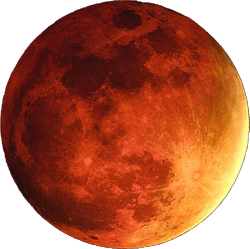
The Bloodmoon signifies Hircine's Great Hunt. Solstheim was the Hunting Grounds this time.
- "It is time we spoke of this. The legend tells of a time that occurs once in each era, when a demon god will walk the land in the company of his Hounds, creatures of terrible might. He is The Hunter, and his coming is preceded by three signs. I had prayed that I had misread the signs, misunderstood the prophecy, but I am sure it is not so."
- ―Korst Wind-Eye[src]
Throughout the eras, the Daedric Prince of the Hunt & the Great Game, Hircine has called upon warriors throughout the continent, to partake in a game, such as the Ritual of the Innocent Quarry (or the Wild Hunt), to hunt a figure such as an Indrik or Herne Egahirn throughout the March of Sacrifices or the remnants of Caecilly Island, or pit various warriors together, to the death, such as this example. Hircine is not exempt from attempting to enter Tamriel, as in 3E 427, Hircine and his forces arrive on the plains of Solstheim, to initiate a Hunt, that is known to the Skaal, as the Bloodmoon Prophecy. Hircine descends onto Tamriel once every era, to pit the greatest warriors of Solstheim against each other, releasing his hounds. 3E 427 is an auspicious time, as it was when Imperial colonies moved onto Solstheim, bringing new potential candidates. There are several signs of the prophecy. It begins when Werewolves appear throughout Solstheim, who would remain on the island as the Frostmoon Pack. Then, "Fire from the Eye of Glass," where a pillar of fire sprouts from the middle of Lake Fjalding. The third sign is the "Tide of Woe," when bodies of dead Horker wash onto shore throughout the northern coast. Finally, the eponymous Bloodmoon of Secunda blots the sky. Hircine's Hunt took place within Mortrag Glacier. A traveler had participated in the hunt, along with, Falx Carius, Tharsten Heart-Fang, and Karstaag. In the end, the mysterious traveler had emerged victorious from Hircine's Hunt, defeating Hircine's Guile of Aspect. While Tharsten & Karstaag were unable to survive, Falx Carius returned to Fort Frostmoth.[16][17][18][19]
Fourth Era
- Main article: Solstheim (Dragonborn)
The Red Year & Morrowind's Expansion
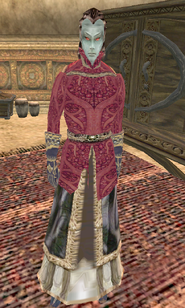
Brara Morvayn, former Councilor of Ald'ruhn & Lady of Maar Gan
- "In the first year of the Fourth Era, after the destruction of Ald'ruhn, many of the Dunmer Great Houses sent out small groups of their own to seek places to reestablish themselves. House Redoran's group was led by Brara Morvayn who immediately struck out for Solstheim. After some quick negotiations with the East Empire Company (and some speculate quite a bit of coin changing hands), Brara's group was allowed to settle in Raven Rock where they quickly became a part of the mining colony's way of life."
- ―Lyrin Telleno[src]
By the time the 3rd Pocket Guide was published in 3E 432, Raven Rock was a flourishing town, between Windhelm and Blacklight, with a population consisting of Imperials and Nords. And by the time the Oblivion Crisis, Raven Rock was unaffected by the forces of Mehrunes Dagon, although, it was unknown whether Oblivion Gates opened in Solstheim, or whether it had affected Fort Frostmoth and the Skaal settlements. With the Fall of Ald'ruhn in the Crisis, House Redoran had sent groups led by Councilors to various territories, to re-established themselves. The city-state of Ald'ruhn was the seat of Redoran's council at the time, but with Skar's destruction, many were forced to relocate. Brara Morvayn, Lady of Maar Gan and Councilor of Ald'ruhn traveled for Raven Rock, and with negotiations with the East Empire Trading Company, the Dark Elves were properly initiated into Solstheim. Although, figures such as Falx Carius were opposed to this, seeing them as a threat. But when the Red Year of 4E 5 had occurred, Solstheim had drastically changed forever. The ensuing ash storm that hit the south had obliterated the Hirstaang Forest, and Raven Rock's wall was severely damaged, barely saving the town. The main province of Morrowind was in a much worse condition, and so minor groups such as House Sathil of the Indoril and House Ulen of the Hlaalu migrated onto Solstheim. The ash swallowed Fort Frostmoth and General Falx Carius. Raven Rock was defenseless, but with the EEC's permission, Brara Morvayn had brought Redoran Guards to protect the city. As more and more refugees arrived onto Solstheim, the then High King of Skyrim had given the region of Solstheim to Morrowind in 4E 16. The East Empire Trading Company had relinquished all holdings of Solstheim to the Great House Redoran, to which it remained so ever since.[11][20][21][22]
Elhul Sathil & the Cursed Blade, Umbra

The Umbra Sword was within the Scathing Bay until Elhul Sathil had found it, going mad from its power.
- "The daedra prince Clavicus Vile wished a weapon made. It was to be an instrument of mischief in Nirn, a source of amusement for him, a weapon that would send him souls. At first, however, he couldn’t find a smith who could do the work. He spent months—some sources say years—in frustration, until the witch Naenra Waerr came forth. She made the weapon, but it was unstable, and she told the prince that he would have to imbue it with some of his own power to make it whole and communicate with it on the mortal plane."
- ―Nirai Sathil[src]
Amidst the rubble of Vivec City, now known as the Scathing Bay, was the accursed sword, Umbra, to which the Sathil noblemen, Elhul Sathil took for his own, and immediately going mad from the blade. Without the soul of Umbra, the sword had become unstable and so Elhul was affected because of this. His madness caused his family to chain him, and take away the Umbra Sword. As time went on, Elhul had recovered but came into possession of the Umbra Sword, leading to his father, Hleryn Sathil, to seal him in a dungeon underneath Castle Sathil, in the Solstheim village of Sathil. The young Dark Elf remained in his cell for years, until the arrival of two travelers. The Crown Prince of the Mede Dynasty, Attrebus Mede, and his aged Dunmeri companions, Ezhmaar Sul had arrived onto Solstheim, seeking the blade of Umbra. Elhul's sister, Nirai Sathil had escorted them to her brother's prison, and trapped them their, hoping that they would kill Elhul and free him from his torment. In the end, Attrebus had unsheathed his trusted-sword, Flashing, and killed Elhul. He wrapped Umbra, so that he would not be affected, and began to part. But Nirai, and House Sathil prevented them from leaving, imprisoning in Elhul's former cell so that Umbra would not go into circulation. This proved to be in vain as both Attrebus & Sul teleported to the Fields of Regret, the Daedric Plane of Clavicus Vile.[OOG 1][OOG 2][OOG 3]
The Colony of Raven Rock; the Dark Elves of Redoran

Modern-day Raven Rock is a combination of East Empire Imperial and Redoran Dunmer architecture.
- "In 4E 16, when Solstheim was passed into the hands of the Dunmer people, the East Empire Company was forced to relinquish Raven Rock's control to House Redoran. The Council quickly named Brara Morvayn as councilor of their new town, and allowed her to rule Solstheim as she saw fit. Brara continued to welcome the Dunmer that elected to settle on Solstheim. Some chose to stay in Raven Rock to work in the mines, and other took to more familiar territory and began a nomadic lifestyle in the ash wastes."
- ―Lyrin Telleno[src]
Brara Morvayn's influence over Raven Rock began with the introduction of House Redoran Guard, and in the aftermath of the Red Year, when Brara commissioned the construction of the Bulwark, to protect Raven Rock from the common ash-storms. Almost a year later, the Bulwark was constructed, and it proved to be a valued asset. The EEC relinquished Raven Rock to House Redoran, and so Brara had complete control over Raven Rock. With the EEC gone, the Imperial population moved back to Cyrodiil, which would have been reigned over by Thules the Gibbering, a year before Titus Mede I took over the Imperial Province. What followed after was Raven Rock's golden years, when peace was prominent, and the Ebony Mine was bringing abundant sums of money. When Councilor Brara Morvayn passed away in 4E 65, her son, Lleril Morvayn took over Raven Rock, and it was well-received by the people, as he was very reminiscent of his mother.[22]
Things went smoothly until in 4E 95, when Vilur Ulen made an assassination attempt on Councilor Lleril. He was saved by the Redoran Guard, under the command of Modyn Veleth. It was revealed to be part of a revenge plot against House Redoran, for they had played a significant role in House Hlaalu's demotion as a Great House. The purpose of the assassination was to send a message to the Grand Council, to demonstrate the Redoran's weakness. Further information showed that Vilur Ulen had attempted to organize a coup d'etat against the Councilor, but he and his conspirators were executed. His descendants remained in hiding on Raven Rock as members of House Severin. As time went on, Raven Rock's prosperity dwindled as in 4E 130, the Bulwark was showing its age, in 4E 150, a group of Argonians attempted to conquer Solstheim, until they were defeated by Councilor Morvayn personally, and in 4E 170, the Raven Rock Ebony Mine had dried out. Councilor Morvayn's attempt to feed his people came out from his pocket, leaving him broke. As a result, some families left Solstheim for the mainland. Raven Rock had been in somewhat of a decline, but people remained regardless of their situation.[23]
The Temple of Miraak & the Corrupted Stones
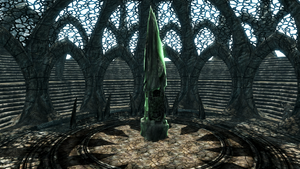
The Tree Stone became the center of the Temple of Miraak. It became corrupted by Miraak.
- "Here in his shrine. That they have forgotten. Here do we toil. That we might remember. By night we reclaim. What by day was stolen. Far from ourselves. He grows ever near to us. Our eyes once were blinded. Now through him do we see. Our hands once were idle. Now through them does he speak. And when the world shall listen. And when the world shall see. And when the world remembers. That world shall cease to be."
- ―Miraak's Mantra[src]
During the Skyrim Civil War in 4E 201, the Last Dragonborn had made their appearance known in the great plains of Whiterun Hold, when they had slain the Dragon known as Mirmulnir. News of this battle had spread across the north, and even as far as Solstheim. At the same time, cultist of the long-dead Miraak had appeared, and the All-Maker Stones became corrupted by his magic. People from as far as Raven Rock, to Thirsk, and in the deep Moesrings were affected. Miraak's cultist traveled for Skyrim to kill the Dragonborn, only to fail, bringing them to Solstheim. Miraak's cultist and his mind-controlled followers constructed the Temple of Miraak around the Tree Stone. Both the Dragonborn and a Skaal, Frea enter the temple, to discover one of the Black Books of Hermaeus Mora. The situation had become clear, Miraak was attempting to re-enter Tamriel, and conquer Solstheim. The Skaal utilized a ward to prevent Miraak's influence from getting to them. Storn Crag-Strider, the village chieftain tasked the Last Dragonborn to travel for Saering's Watch, a Dragon Aerie in the Moesring Mountains, where they acquired the shout of Bend Will, a long-forgotten Thu'um that was used by Miraak during his time as Dragon Priest. With this powerful shout, the Last Dragonborn traveled to all of the All-Makers Stones, freeing everyone from Miraak's power.[24][25][26][27]
Miraak's Downfall; At the Summit of Apocrypha
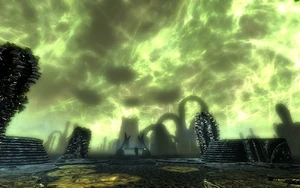
The realms of Apocrypha contain ancient and forbidden knowledge. It is the domain of Hermaeus Mora.
- "The infinite archives of Hermaeus Mora are the ultimate treasure. Its innumerable shelves and countless books carry the weight of all knowledge. Therein, the diligent reader can find all that was, all that is, and all that will be. We have seen the truth. Knowledge is only as wicked as the one who wields it. Forsaking learning in fear of its misuse is the ultimate sin. It is an unforgivable folly. As a result, mortals have suffered countless centuries of loss."
- ―Anonymous[src]
The Revival of Raven Rock; the Second Golden Age
Locations
Regions
- Felsaad Coast
- Hirstaang Forest (Solstheim Ashlands)
- Isinfier Plains
- Moesring Mountains
Settlements
- Raven Rock
- Bujold's Retreat
- Fort Frostmoth (Settlement)
- Haknir's Shoal
- Northshore Landing
- Old Attius Farm
- Oleen Mar
- Ramshackle Trading Post
- Sathil
- Skaal Village
- Tel Mithryn
- Thirsk Mead Hall
Ruins
- Ashfallow Citadel
- Bloodskal Barrow
- Connorflenge Barrow
- Eddard Barrow
- Fahlbtharz
- Fort Frostmoth (Ruins)
- Frosselmane Barrow
- Glenschul's Tomb
- Gyldenhul Barrow
- Highpoint Tower
- Himmelhost Barrow
- Hrothmund's Barrow
- Jolgeirr Barrow
- Kagrumez
- Kelsedolk Barrow
- Kolbjorn Barrow
- Lukesturm Barrow
- Morvayn Ancestral Tomb
- Nchardak
- Patchwork Airship
- Skogsdrake Barrow
- Snowclad Ruins
- Stormpfund Barrow
- Tombs of Skaalara
- Ulen Ancestral Tomb
- Vahlok's Tomb
- Valbrandr Barrow
- White Ridge Barrow
Caves
- Benkongerike
- Bjorn
- Bristleback Cave
- Broken Tusk Mine
- Caves of Fjalding
- Cave of Hidden Music
- Coldcinder Cave
- Damphall Mine
- Domme
- Fjell
- Frossel
- Frostmoon Crag
- Frykte
- Gandrung Caverns
- Glacial Cave
- Gloomy Cave
- Gronn
- Halls of Penumbra
- Lair of the Udyrfrykte
- Legge
- Rimhull
- Sjobal
- Skygge
- Solvjord
- Stahlman's Gorge
- Varstaad Caves
Landmarks
- Altar of Thrond
- Beast Stone
- Brodir Grove
- Castle Karstaag
- Earth Stone
- Ensleth Valley
- Harstrad River
- Horker Island
- Hrothmund's Bane
- Hvitkald Peak
- Iggnir River
- Isild River
- Lake Fjalding
- Mortrag Glacier
- Mount Moesring
- Saering's Watch
- Sea of Ghosts
- Stalhrim Source
- Sun Stone
- Thormoor's Watch
- Tree Stone
- Water Stone
- Wind Stone
Gallery
Trivia
- In An Elder Scrolls Novel: The Infernal City the island is referred as Soulstheim. It is probably an error of the author, since he uses the habitual name Solstheim for An Elder Scrolls Novel: Lord of Souls.
Appearances
- The Elder Scrolls III: Morrowind (mentioned only)
- The Elder Scrolls IV: Oblivion (mentioned only)
- An Elder Scrolls Novel: The Infernal City (mentioned only)
- An Elder Scrolls Novel: Lord of Souls
- The Elder Scrolls V: Skyrim (mentioned only)
- The Elder Scrolls Online (mentioned only)
References
- ↑ 1.0 1.1 Fall of the Snow Prince
- ↑ Diary of Faire Agarwen
- ↑ 3.0 3.1 The Guardian and the Traitor
- ↑ Dialogue with Tharstan
- ↑ Crafting Motif 46: Stalhrim Frostcaster Style
- ↑ The Second Akaviri Invasion
- ↑ Dialogue with Lady Clarisse Laurent
- ↑ Events of The Elder Scrolls Online
- ↑ Map of Tamriel & the Alliance Core Regions
- ↑ Thirsk, a Revised History
- ↑ 11.0 11.1 History of Raven Rock, Vol. I
- ↑ Events of "Making a Choice"
- ↑ Events of "Discovery in the Mine"
- ↑ Events of "Under Siege/Drastic Measures"
- ↑ Events of "The Factor's Estate"
- ↑ Events of "The Skaal Test of Strength"
- ↑ Events of "Siege of the Skaal Village"
- ↑ Events of "Hircine's Hunt"
- ↑ The Posting of the Hunt
- ↑ Letter to Imperial City
- ↑ Decree of Monument
- ↑ 22.0 22.1 History of Raven Rock, Vol. II
- ↑ History of Raven Rock, Vol. III
- ↑ Events of "Dragonborn"
- ↑ Events of "The Temple of Miraak"
- ↑ Events of "The Fate of the Skaal"
- ↑ Events of "Cleansing the Stones"
- ↑ An Elder Scrolls Novel: Lord of Souls (Part 2, Chapter 9)
- ↑ An Elder Scrolls Novel: Lord of Souls (Part 2, Chapter 13)
- ↑ An Elder Scrolls Novel: Lord of Souls (Part 2, Chapter 19)
| Morrowind Locations in Lore | |
|---|---|
| Cities | Ald'ruhn • Balmora • Blacklight • Brass Fortress • Ebonheart • Firewatch • Kragenmoor • Mournhold • Narsis • Necrom • Port Telvannis • Sadrith Mora • Tear • Vivec City |
| Regions | Bal Foyen • Clockwork City • Dejayste • Deshaan • Stonefalls • Telvanni Peninsula • Thornmarsh • Vvardenfell (Miscellaneous: Gorne • Solstheim • Northeast Archipelago) |
| Landmarks | Bamz-Amschend • Brothers of Strife • Cavern of the Incarnate • Ghostgate • Holamayan Monastery • Inner Sea • Kogoruhn • Mournhold Temple • Red Mountain • Shrine of Saint Veloth • Vivec's Antlers |


